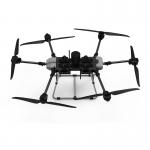Product Background
Demand for agricultural production scale: With the development of
agricultural modernization, large-scale planting patterns have
become increasingly common, and the area of farmland has been
expanding continuously. Higher requirements have been put forward
for agricultural operation efficiency. Traditional electric
agricultural drones have small payloads and short flight time,
making it difficult to meet the needs of pesticide spraying, sowing
and other operations in large-scale farmland. For example, in
planting bases of tens of thousands of acres in regions like
Xinjiang, large-capacity, long-range drones are needed to improve
operation efficiency and reduce costs. The YD-50 six-axis
gasoline-powered drone can carry large amounts of pesticides, seeds
and other materials, and has a longer flight duration, which can
better adapt to large-scale agricultural production operations.
Development of drone technology: The continuous development of
drone-related technologies has laid the foundation for it. On one
hand, advancements in material technology enable the use of
lightweight and high-strength materials such as carbon fiber for
the drone body, which can reduce weight while maintaining
structural strength, thereby improving the carrying capacity. On
the other hand, the continuous improvement of flight control
systems allows the six-axis drones to be better controlled in
flight, ensuring stable flight even with large payloads.
Additionally, the improvement of engine technology enables gasoline
engines to provide more efficient power for the drones, solving the
problem of insufficient power for electric drones.
Breaking through the bottleneck of electric drones: Traditional
electric multi-rotor drones have the limitations of small payload
and short flight time, making it difficult to meet the requirements
of industrial-level applications. However, gasoline engines have
the characteristic of high power-to-weight ratio, and applying
fuel-powered piston engines to multi-rotor drones, through
innovations in flight control and engine control technologies, can
overcome technical difficulties such as long engine response time,
high non-linearity, and large vibration amplitude, significantly
enhancing the payload and flight duration of the drones, and
promoting the entry of drones into the industrial-level application
field.
Expansion of market application scenarios: Besides the agricultural
field, industrial-level drones are also increasingly widely used in
fire fighting, power line inspection, and logistics transportation.
These fields also have high requirements for the payload and flight
duration of drones. For example, in the fire fighting field, drones
need to carry fire-fighting equipment or water hoses for
high-altitude firefighting, and in power line inspection, drones
need to fly for a long time to cover longer routes. The YD-50
six-axis gasoline-powered drone, with its performance advantages,
can meet the diverse industrial-level application scenarios
requirements, and has broad market prospects.
Product parameters
| Attribute | Customized model |
Product display










